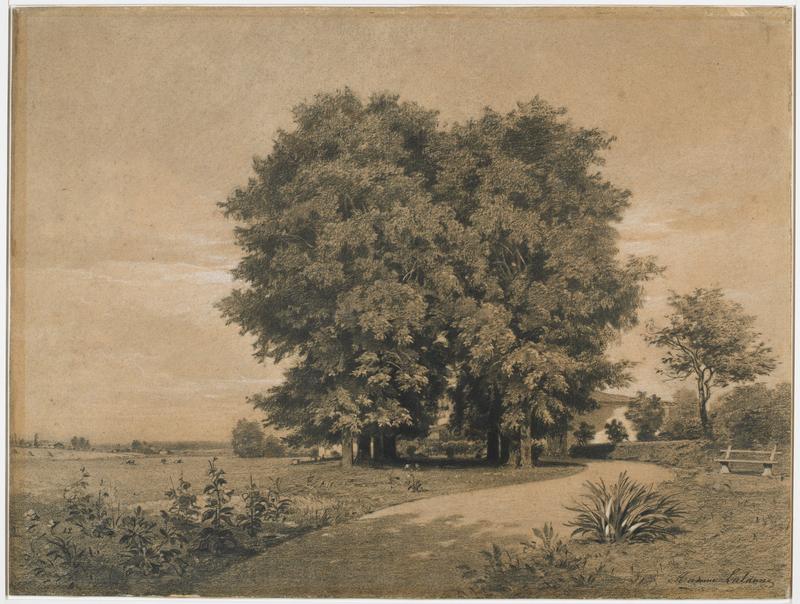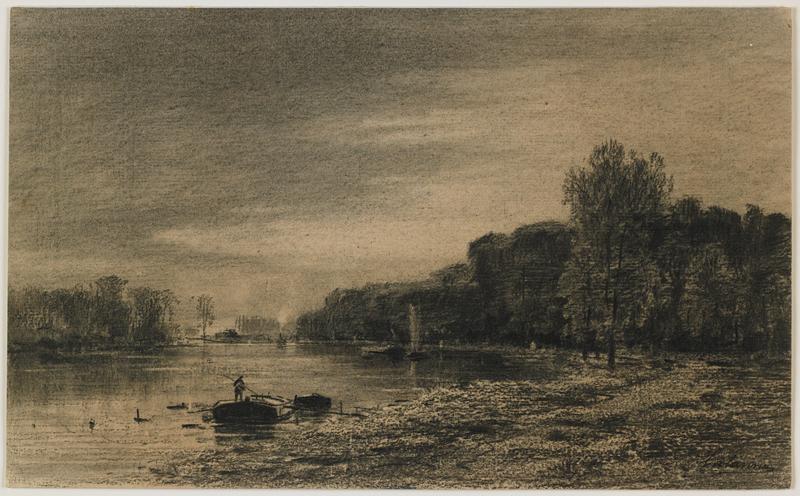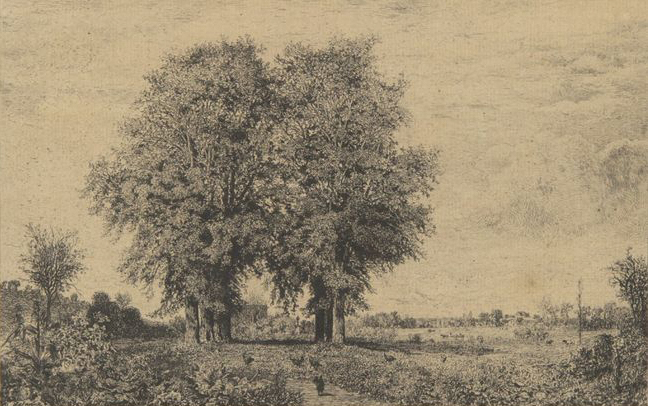

100–101. Maxime Lalanne, Landscape with a House Behind Large Elm Trees near Bordeaux and River Landscape
| Artist | Maxime Lalanne, French, Bordeaux 1827–Nogent-sur-Marne (Seine) 1886 |
| Title, Date | Landscape with a House Behind Large Elm Trees near Bordeaux, not dated |
| Medium | Charcoal heightened with white chalk on off-white paper |
| Dimensions | 16 7/16 × 22 in. (41.8 × 55.9 cm) |
| Inscriptions + Marks | Lower right: Maxime Lalanne |
| Provenance | [Galerie Fischer-Kiener, Paris, until about 1982; to Weisberg]; Yvonne and Gabriel Weisberg, Minneapolis |
| Exhibition History | "The Quieter Image: 19th Century European Drawings and Watercolors," Carleton Art Gallery, Carleton College, Northfield, Minn., 1996, no. 30; "Expanding the Boundaries: Selected Drawings from the Yvonne and Gabriel P. Weisberg Collection," Mia (2008) and Snite Museum of Art, Notre Dame, Ind. (2010); "Trees Lovely as a Poem," Mia, 2015; "Reflections on Reality: Drawings and Paintings from the Weisberg Collection," Mia, 2022–23 |
| References | Lisa Dickinson Michaux with Gabriel P. Weisberg, "Expanding the Boundaries: Selected Drawings from the Yvonne and Gabriel P. Weisberg Collection" (exh. cat.), Minneapolis Institute of Arts (Minneapolis, 2008), pp. 70–72, 88, fig. 40 |
| Credit Line | Promised gift of Gabriel P. and Yvonne M.L. Weisberg, Minneapolis |
| Artist | Maxime Lalanne, French, Bordeaux 1827–Nogent-sur-Marne (Seine) 1886 |
| Title, Date | River Landscape, not dated |
| Medium | Charcoal on off-white laid paper |
| Dimensions | 7 1/16 × 11 1/2 in. (17.9 × 29.2 cm) |
| Inscriptions + Marks | Lower right in black: Lalanne |
| Provenance | [Paul Prouté S. A., Paris, until about 1987; to Weisberg]; Yvonne and Gabriel Weisberg, Minneapolis |
| Exhibition History | "Expanding the Boundaries: Selected Drawings from the Yvonne and Gabriel P. Weisberg Collection," Mia (2008) and Snite Museum of Art, Notre Dame, Ind. (2010); "Reflections on Reality: Drawings and Paintings from the Weisberg Collection," Mia, 2022–23 |
| References | Lisa Dickinson Michaux with Gabriel P. Weisberg, "Expanding the Boundaries: Selected Drawings from the Yvonne and Gabriel P. Weisberg Collection" (exh. cat.), Minneapolis Institute of Arts (Minneapolis, 2008), pp. 6, 72, fig. 41 |
| Credit Line | Promised gift of Gabriel P. and Yvonne M.L. Weisberg, Minneapolis |
Born and raised in Bordeaux, Maxime Lalanne first pursued art as a pastime while embarking on a legal career. His talent was soon recognized, and he was persuaded to pursue art full time. In 1852 he moved to Paris to study at the École des Beaux-Arts (School of Fine Arts). That same year, he successfully entered two charcoal drawings at the Paris Salon. He went on to become a regular Salon entrant and eventually a juror.
Though he was an avid, prolific, and skillful draftsman, Lalanne is probably best remembered for his activity as a printmaker and an author of technical handbooks. His etchings were admired for their technical mastery and tidy finish. As an advocate for the medium, he was one of the original members of the Société des Aquafortistes (Society of Etchers), founded in 1862. His manual on etching, first published in 1866,1 continues to be reprinted in our own century. Next he wrote Le Fusain (1869), a guide to charcoal drawing.2 It was the first treatise on the subject and it, too, went into multiple editions.

Lalanne became thoroughly Parisian but retained close ties to Bordeaux, sketching in and around the city during vacations.3 He seems to have been partial to a village called Cenon. It has now been incorporated into the environs of Bordeaux, but in Lalanne’s day it was lightly populated. Landscape with a House relates closely to Lalanne’s etching The Elms of Cenon, dated 1874 (fig. 1).4 The drawing, then, may stem from a visit to Bordeaux during the early 1870s. The resemblance between the two works, in particular the grove of trees and the overall composition, is especially close when one bears in mind the image reversal inherent in the process of printing etchings.
The two Lalanne charcoals in the Weisberg Collection differ in tone and technique: one is large and precise, the other small and atmospheric. Landscape with a House shows Lalanne’s ability to capture the simplicity and grandeur of nature in ways that tie him to Realism and Romanticism. The landscape is carefully groomed; the path is neatly edged. This could even be the country estate of a wealthy owner for whom grazing livestock were as much an ornament as a business proposition. In keeping with the manicured view, Lalanne subordinated gesture to the detailed rendering of form, texture, space, and lighting. Firm, carefully placed lines define the contours of foreground plants and other details. He built up the leafy mass of the trees with countless clusters of tight squiggles, many of which he then smudged to produce a play of light that suggests volume and intricacy. His use of white chalk lights up the wispy clouds, plants, and partially seen house. The scale and elaborate finish mark this drawing as a work intended for public display.
The smaller River Landscape, whose precise location remains unknown, shows a freer side of Lalanne’s draftsmanship, especially in the atmospheric sky. Here Lalanne thoroughly smudged his charcoal to eliminate individual strokes, instead creating vaporous shadows. The half-darkened sky invites us to imagine the change of light at dusk or an imminent change of weather. Though Lalanne detailed elements of the scene, such as the boat and its occupant, he displayed less self-conscious precision on this smaller sheet.
TER and GPW
Notes
Maxime Lalanne, Traité de la gravure à l’eau-forte (Paris: Cadart & Luquet, 1866). ↩︎
Maxime Lalanne, Le Fusain (Paris: L. Berville, 1869). ↩︎
Many of Lalanne’s prints and drawings documented the destruction of old Paris under Baron Hausmann, who created modern Paris by building wide boulevards to—in the words of Napoleon III—“aérer, unifier, et embellir” (air out, unify, and embellish) Paris and to more easily control the city in the event of demonstrations or riots. ↩︎
Henri Beraldi, Les graveurs du XIXe siècle, guide de l’amateur d’estampes modernes (Paris: Librairie L. Conquet, 1889), vol. IX, p. 21, no. 109. Lalanne showed the print in the Salon of 1874; see P. Leroi, “Les Aquarelles, dessins, gravures au Salon de 1874,” Gazette des Beaux-Arts, vol. 2 (August 1874), p. 161, ill. ↩︎